| exodus |
Home |
Overview lecture |
Capabilities |
Projects |
Publications |
Animations |
News | Press releases | Leaflets | Team | Visitor registration | Demo software | Licensed Users Area | Contact details |
EXODUS ANIMATIONS
Back to Animation Gallery main page
Following are the animations generated by FSEG staff using the EXODUS software.
Note: Either freely available Real One Player Basic or Windows media player is required to play the following animations.
 Urban scale evacuation simulation using buildingEXODUS V6.X. Simulation involves 250,000 agents over an area of 1.2 km x 1.2 km, software interfaces with Open Street Map to generate the geometry. Animation date: November 2013 Windows Media Video (good quality) [25.8 MB] |  Simulation of high-rise building circulation using elevators using buildingEXODUS V6.0 displayed in buildingEXODUS 3D graphics. Animation date: November 2013 Windows Media Video (good quality) [13.3 MB] |
 Simulation of high-rise building evacuation using elevators using buildingEXODUS V6.0 displayed in buildingEXODUS 3D graphics. Animation date: June 2009 Windows Media Video (good quality) [9.78 MB] |  buildingEXODUS V4.0 simulation of the Rhode Island nightclub fire. The fire conditions are predicted using SMARTFIRE V4.1. The simulation predicts evacuation through available doors and windows. A number of people perish in this simulation due to the rapidly developing fire. Animation date: January 2009 Windows Media Video (good quality) [9 MB] |
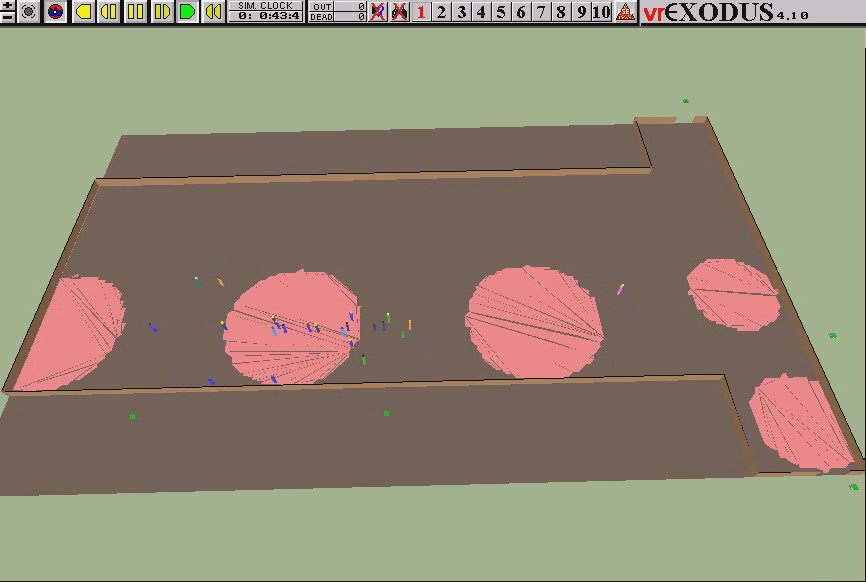 buildingEXODUS V4.1 demonstration of agents using signage systems to navigate through an unfamiliar geometry. The red circles depict the VCA of the various signs, note they do not overlap. Communication is also available where “lost” agents can ask knowledgeable building staff (in green) or other agents the direction to their target location (exit at bottom right of animation). Animation date: January 2009 Windows Media Video (good quality) [2.97 MB] |  maritimeEXODUS V4.1 simulation of State 1 Preps procedure on a frigate. The various tasks that the crew are undertaking are assigned using the itinerary function of the software. Note that crew are climbing vertical ladders and step 60 degree ladders, opening and closing water tight doors and hatches. These special capabilities are available in maritimeEXODUS. Animation date: January 2009 Windows Media Video (good quality) [7.87 MB] |
 buildingEXODUS V4.0 simulation of highrise building evacuation. Animation is prepared using the PC WINROAD software of FORUM8 using the newly developed EXODUS-WINROAD link. Animation date: January 2009 Windows Media Video (good quality) [7.45 MB] |  buildingEXODUS V4.1 simulation of pedestrian dynamics in an airport terminal. Included in this simulation is queuing, complex passenger itineraries, passengers collecting baggage, passengers passing through immigration, security checks, etc. Animation date: January 2008 Windows Media Video (good quality) [13.8 MB] |
 buildingEXODUS V4.0 is used to investigate a hypothetical tunnel fire evacuation. The fire is conditions are generated by the SMARTFIRE V4.0 software. In this scenario, the tunnel exits are placed 100 m apart and occupants are given instant response times. In this case many occupants fail to exit the tunnel prior to life threatening conditions developing. Animation date: March 2005 Windows Media Video (good quality) [5.67 MB] |  maritimeEXODUS V4.0 simulation of the sinking of the Gustloff. Population density mode is depicted to represent the crowding generated as the vessel heals over. This animation was shown on the Discovery Channel as part of their documentary on the sinking of the vessel. Animation date: March 2004 Windows Media Video (good quality) [10.4 MB] |
 buildingEXODUS V4.0 simulation of pedestrian dynamics in underground station. Passengers are entering and leaving the station throughout the simulation. The various tasks are assigned to the passengers using the itinerary functionality of the software. Animation date: March 2004 Windows Media Video (good quality) [9.43 MB] | 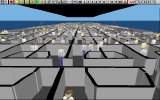 vrEXODUS V3.0 representation of a maritimeEXODUS V3.0 simulation of an IMO night case evacuation scenario evacuation involving 5 passenger decks on a large passenger ship. The vessel has 650 passengers in three vertical fire zones. The vessel easily completes the mustering process well within the allocated time. Animation date: January 2004 Real Media (low quality) [9 sec] Real Media (good quality) [730 KB] |
 maritimeEXODUS V4.0 simulation of a night case evacuation scenario involving fire. This shows the end point of the fire shown in the previous window. Using the FED heat and toxicity models, mEX has predicted a number of fatalities in this evacuation. The end location and starting points of the fatalities are depicted in this animation. Animation date: January 2003 Real Media (low quality) [29 sec] Real Media (good quality) [1.36 MB] |  maritimeEXODUS V4.0 simulation of a night case evacuation scenario involving fire. The scenario has a fire imported from SMARTFIRE. The fire commences in a cabin and smoke and heat begin to spread throughout the corridors on this deck and other connected decks. The vessel has 650 passengers in three vertical fire zones. Paxs react with the normal IMO night time response times. Animation date: January 2003 Real Media (low quality) [32 sec] Real Media (good quality) [1.51 MB] |
 vrEXODUS V1.11 representation of a maritimeEXODUS V3.0 simulation of emergency evacuation involving 7 decks (5-11) within a vertical fire zone. A fire starts on one of the lower decks and the muster deck is 8. Animation date: January 2002 Real Media (low quality) [1:57 min] Real Media (good quality) [6.29 MB] |  vrEXODUS depiction of IMO day case evacuation. Animation date: January 2002 Real Media (low quality) [47 sec] Real Media (good quality) [2.62 MB] |
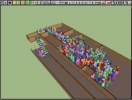 buildingEXODUS V3.0 is used to re-create the Gothenburg Disco fire. This simulation uses data generated by fire model and experimental data. The fire data is automatically transferred to the evacuation simulation. The simulation makes use of the buildingEXODUS toxicity model to investigate incapacitation and death of victims. Animation date: January 2002 Real Media (low quality) [37 sec] Real Media (good quality) [2.15 MB] | 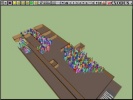 buildingEXODUS V3.0 is used to investigate the Gothenburg Disco fire. Unlike in the previous simulation, here buildingEXODUS is used to examine what would have happened had an additional exit been available on the upper floor. In this case, everyone manages to escape with some survivors experiencing minor injuries. Animation date: January 2002 Real Media (low quality) [37 sec] Real Media (good quality) [2.01 MB] |
 vrEXODUS representation of an airEXODUS simulation of evacuation from a hypothetical double deck aircraft using all available exits. The model includes 580 passengers and the aircraft has nine pairs of Type A exits, four on the upper deck and five on the lower deck. Animation date: January 2002 Real Media (low quality) [11 sec] Real Media (good quality) [760 KB] |  vrEXODUS representation of a buildingEXODUS simulation of the World Trade Centre Evacuation for WTC1. The model covers 110 floors and includes 7,000 people. Approximately 5544 occupants are located below the impact floors and all manage to evacuate within approximately 1 hour 34 minutes. The building collapsed in 1 hour 42 minutes. Animation date: January 2002 Real Media (low quality) [8 sec] Real Media (good quality) [707 KB] |
 vrEXODUS V1.0 representation of a buildingEXODUS prototype simulation of emergency evacuation from a large building that is on fire. Part way through the animation occupants are in non-emergency mode as they go about their normal business until the fire alarm is heard. They then go into evacuation mode. Animation date: January 2001 Real Media (low quality) [1:34 min] Real Media (good quality) [2.02 MB] |  buildingEXODUS V3.0 simulation of non-emergency passenger movement from 8 carriage train to end of gated platform. Software is operated in population density mode. Red indicates high population density areas. Animation date: January 2001 Real Media (low quality) [1 min] Real Media (good quality) [1.1 MB] |
 vrEXODUS V1.0 representation buildingEXODUS simulation of non-emergency passenger movement from 8 carriage train to end of gated platform. Animation date: January 2001 Real Media (low quality) [1:28 min] Real Media (good quality) [1.9 MB] |  vrEXODUS V1.0 representation of airEXODUS simulation of emergency evacuation from an aircraft. Animation date: January 2001 Real Media (low quality) [2:43 min] Real Media (good quality) [3.9 MB] |
 buildingEXODUS V3.0 simulation of emergency evacuation from a building on fire. Toxicity and hazard models are activated. Smoke contours and temperatures contours are depicted. Animation date: January 2001 Real Media (low quality) [1:34 min] Real Media (good quality) [2.5 MB] |  vrEXODUS V1.0 representation of a buildingEXODUS simulation emergency evacuation from a building fire. Occupants are becoming incapacitated due to heat and toxic gas inhalation. Animation date: January 2001 Real Media (low quality) [16.4 sec] Real Media (good quality) [396 KB] |
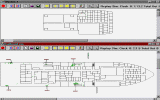 maritimeEXODUS V1.0 simulation of emergency evacuation from two decks of a passenger ship. Passengers are moving towards their muster stations after they collect lifejackets from cabins. Animation date: January 2001 Real Media (low quality) [2:09 min] Real Media (good quality) [2 MB] | 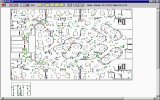 maritimeEXODUS V2.0 simulation of IMO day case. Single deck from a vertical zone is shown depicting dinning area. Population density is used to show congestion regions. Animation date: January 2001 Real Media (low quality) [32 sec] Real Media (good quality) [577 KB] |
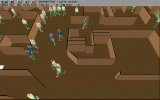 vrEXODUS V1.0 representation of a buildingEXODUS V3.0 simulation of emergency evacuation from a large building that is on fire. Some occupants elect to redirect from smoke regions and use more distant exits with which they are familiar. Animation date: January 2001 Real Media (low quality) [1:29 min] Real Media (good quality) [1.9 MB] |  Smoke and heat display as represented in vrEXODUS V2.0b. Fire atmosphere predicted using CFAST and simulation run in buildingEXODUS V3.0. Animation date: January 2001 Real Media (low quality) [45 sec] Real Media (good quality) [889 KB] |
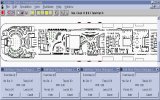 maritimeEXODUS V2.0 simulation of abandonment phase. Single deck of a large cruise ship is shown. Pax’s make their way from muster stations to life boats. When full, pax’s move onto next life boat. Animation date: January 2001 Real Media (low quality) [1: 45 min] Real Media (good quality) [1.91MB] |  maritimeEXODUS V2.0 simulation of normal pax circulation on a large pax ship. Population density is used to show congestion regions. Animation date: January 2001 Real Media (low quality) [3:10 min] Real Media (good quality) [3.39 MB] |
 maritimeEXODUS V2.0 simulation of IMO night case. Single deck from a vertical zone is shown depicting cabins. Population density is used to show congestion regions. Animation date: January 2001 Real Media (low quality) [17 sec] Real Media (good quality) [280 KB] |  vrEXODUS V1.0 representation of a maritimeEXODUS V1.0 simulation of emergency evacuation from two decks of a passenger ship. Passengers are moving towards their muster stations after they collect lifejackets from cabins. Animation date: January 2001 Real Media (low quality) [2:07 min] Real Media (good quality) [2.5 MB] |
 High-rise building evacuation predicted using buildingEXODUS V3.0 and displayed using vrEXODUS. Animation date: January 2000 Real Media (low quality) [26 sec] Real Media (good quality) [562 KB] |  buildingEXODUS V2.0 simulation of non-emergency movement of people from two trains and into a large station complex. Software is operated in population density mode. Red indicates high population density. Animation date: January 1999 Real Media (low quality) [1:25 min] Real Media (good quality) [1.8 MB] |
 buildingEXODUS V2.0 simulation of non-emergency movement of people from a football ground. Software is operated in population density mode. Red indicates high population density. Animation date: January 1999 Real Media (low quality) [37 sec] Real Media (good quality) [1.1 MB] |  EXODUS V2.0 Tutorial. Animation date: January 1998 Real Media (low quality) [28.5 sec] Real Media (good quality) [626 KB] |

